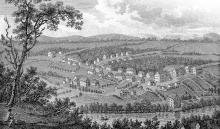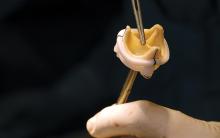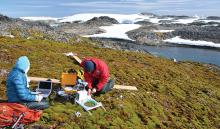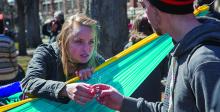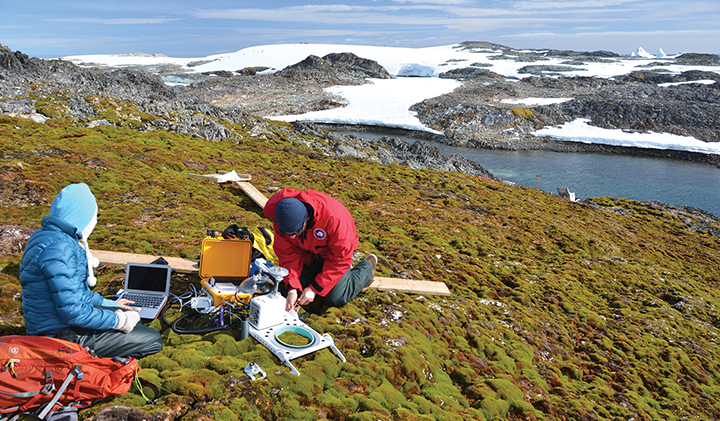
Antarctica is going green—and that is not a good thing. Rising temperatures affect the growth of moss on the continent, and these climatic changes are being studied by paleoecologist Zicheng Yu.
The western Antarctic peninsula has experienced dramatic climate change over the last century or so with temperatures rising at a much higher rate than elsewhere. Since 1950, temperatures in the peninsula have risen by about more than half a degree each decade—much quicker than the global average.
“Our goal is to see how the ecosystem responded to climate change over the last several decades and to understand possible change in the future,” says Yu, professor of earth and environmental sciences. “We can use natural experiments as preserved in peat deposits to reveal what happened over the last 2,000 years—the changes in ice, the snow and the ecosystem in response to climate warming.”
Yu and his colleagues, including co-principal investigator David Beilman at the University of Hawaii; his postdoc, Julie Loisel, now a professor at Texas A&M University; and Lehigh graduate student Jonathan Stelling, use peat moss banks to study changes in the region’s climate over the last 2,000 years by drilling cores from peat moss.
More than 99 percent of Antarctica is covered by ice, so there is little space for plants to grow. And life is tough for most plants. In the Antarctic, there are only two species of flowering plants, Antarctic hair grass and Antarctic pearlwort. There are also two main peat-forming mosses, those associated with deposits of decaying organic matter. Hair grass is a greenish-looking turf moss that favors drier conditions, while pearlwort prefers a wet environment. Yu said his team is investigating a hypothesis that conditions along the Antarctic peninsula are favoring the wetter species over the drier one, possibly due to increases in precipitation or longer snowmelt seasons during the summer when the moss grows.
Yu’s team takes collected core samples back to the lab, where Lehigh researchers compare ratios of stable isotopes of oxygen and hydrogen, which vary depending on environmental conditions at a specific point in time as well as analyze botanical composition to investigate vegetation changes.
“The exciting part is we are always finding something new, as Antarctica is literally science frontier,” Yu says. “We’ve observed peat-forming mosses in two areas. These mosses are either in highland areas on rocky slopes, forming aerobic peat banks, or in lowland areas where waterlogged peat land is forming, a type of ecosystem that we’ve never seen before in Antarctica.”
These low-level peat lands are indicative of a rising water table as well as high temperatures, and peat lands are major reservoirs of carbon. In the lab, information collected from the isotopic analyses can include a record in changes not only of temperature, but in atmospheric circulation and ocean conditions. Yu and his colleagues are particularly interested in a time period that occurred about 800 years ago called the Medieval Warm Period, when temperatures were comparable to today, before a so-called Little Ice Age cooled the planet for several hundred years. The team’s findings indicate the peat lands may be the result of a full-blown ecosystem change.
“This ecosystem change is likely responding to recent climate warming,” says Yu. “We’ve recorded increasing air temperatures and radiation heating of peat surfaces. A new ecosystem is forming. With less ice and warmer temperatures, it might be happening now.”





